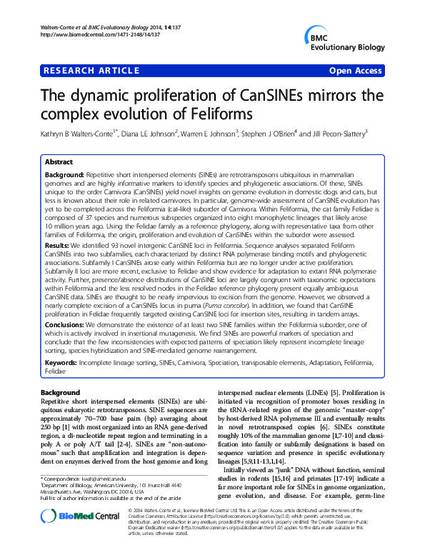
- Incomplete lineage sorting,
- SINEs,
- Carnivora,
- Speciation,
- Transposable elements,
- Adaptation,
- Feliformia,
- Felidae
Background: Repetitive short interspersed elements (SINEs) are retrotransposons ubiquitous in mammalian genomes and are highly informative markers to identify species and phylogenetic associations. Of these, SINEs unique to the order Carnivora (CanSINEs) yield novel insights on genome evolution in domestic dogs and cats, but less is known about their role in related carnivores. In particular, genome-wide assessment of CanSINE evolution has yet to be completed across the Feliformia (cat-like) suborder of Carnivora. Within Feliformia, the cat family Felidae is composed of 37 species and numerous subspecies organized into eight monophyletic lineages that likely arose 10 million years ago. Using the Felidae family as a reference phylogeny, along with representative taxa from other families of Feliformia, the origin, proliferation and evolution of CanSINEs within the suborder were assessed.
Results: We identified 93 novel intergenic CanSINE loci in Feliformia. Sequence analyses separated Feliform CanSINEs into two subfamilies, each characterized by distinct RNA polymerase binding motifs and phylogenetic associations. Subfamily I CanSINEs arose early within Feliformia but are no longer under active proliferation. Subfamily II loci are more recent, exclusive to Felidae and show evidence for adaptation to extant RNA polymerase activity. Further, presence/absence distributions of CanSINE loci are largely congruent with taxonomic expectations within Feliformia and the less resolved nodes in the Felidae reference phylogeny present equally ambiguous CanSINE data. SINEs are thought to be nearly impervious to excision from the genome. However, we observed a nearly complete excision of a CanSINEs locus in puma (Puma concolor). In addition, we found that CanSINE proliferation in Felidae frequently targeted existing CanSINE loci for insertion sites, resulting in tandem arrays.
Conclusions: We demonstrate the existence of at least two SINE families within the Feliformia suborder, one of which is actively involved in insertional mutagenesis. We find SINEs are powerful markers of speciation and conclude that the few inconsistencies with expected patterns of speciation likely represent incomplete lineage sorting, species hybridization and SINE-mediated genome rearrangement.
Available at: http://works.bepress.com/stephen-obrien/211/

© 2014 Walters-Conte et al.; licensee BioMed Central Ltd. This is an Open Access article distributed under the terms of the Creative Commons Attribution License (http://creativecommons.org/licenses/by/2.0), which permits unrestricted use, distribution, and reproduction in any medium, provided the original work is properly credited. The Creative Commons Public Domain Dedication waiver (http://creativecommons.org/publicdomain/zero/1.0/) applies to the data made available in this article, unless otherwise stated.